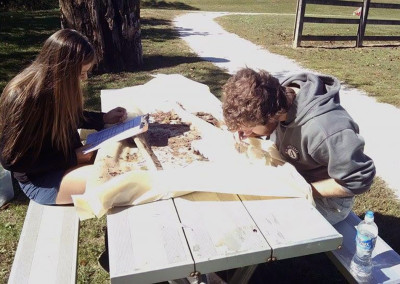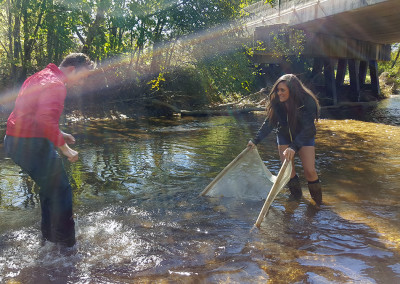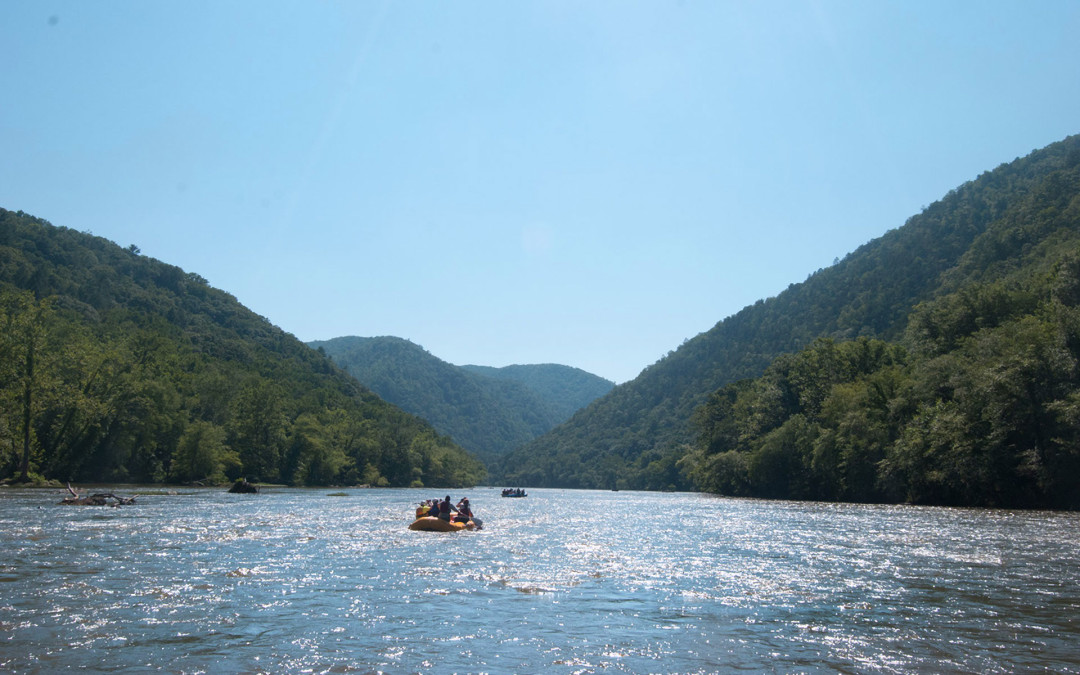MountainTrue and Sierra Club Respond to Duke Energy’s Revised ‘Modernization’ Project
Media contacts:
Karim Olaechea, MountainTrue
E: karim@mountaintrue.org, C: 415-535-9004
Melissa Williams, Sierra Club
E: melissa.williams@sierraclub.org, C: 828-545-0443
ASHEVILLE, NC – Duke Energy today announced a dramatic reconfiguration to their Carolinas Modernization Project, scrapping a proposed 40-mile transmission line that would have cut through the counties of Buncombe, Henderson and Polk in North Carolina and Spartanburg in South Carolina; eliminating a new substation in Campobello, S.C.; and reducing the size of a proposed new natural gas plant slated to replace the current coal-fired plant at Lake Julian outside of Asheville.
At the press conference, Duke Energy laid out the specifics of their revision: Whereas the company had initially proposed a single 650-megawatt natural gas-powered plant, Duke Energy now plans to build two side-by-side 280-megawatt natural gas units, 90 megawatts less than what was originally proposed.
The company has said that they will work with the City of Asheville to fulfill the recently adopted Clean Energy Framework and that construction of an additional 190 MW peaking unit (one that is only used when power demand is at its high) in 2023 could be delayed through greater collaboration on energy efficiency programs, renewable energy, demand-side management, and new technologies.
Julie Mayfield, co-director of MountainTrue — the primary organizer of the Carolina Land Coalition:
“Eliminating transmission lines and a proposed substation is a significant win for the residents of Western North Carolina and upstate South Carolina. We came together, voiced our concerns, and Duke Energy heard our call. We applaud Duke for listening to our communities, going back to the drawing board and setting a new course that is more consistent with our values and respectful of our region’s natural heritage.
Today we can celebrate but tomorrow we go back to work. Though we are pleased the proposed plant is smaller than originally proposed, natural gas is still a major contributor to climate change, and our region is already feeling the impacts.
MountainTrue and the Carolina Land Coalition look forward to working with Duke Energy, the City of Asheville, and others throughout the region to marshal new resources and make meaningful investments in renewable energy, energy efficiency and demand reduction. Through that collaborative work, we can achieve the clean energy future we all want and need.”
Kelly Martin, senior campaign representative for the Beyond Coal campaign in North Carolina, said:
“We’re glad to see that Duke Energy is responding to the concerns of people in WNC by abandoning the transmission lines, paring down the scale of this oversized project, and delaying the build of a portion of the natural gas plant to give time for clean energy solutions to get in place. The cost of investing in clean, reliable, renewable energy sources is dropping rapidly. Investments in energy efficiency and clean energy are a smart bet and, if done right, could prevent the need for any more natural gas to be built in our region. The City of Asheville’s recently adopted Clean Energy Framework is a great place for these solutions to take shape.
We look forward to the day when Duke Energy ends its reliance on fossil fuels altogether, for the sake of our public health, water quality, and slowing down climate change.”
**read below for more reactions in bold**
How We Got To This Announcement
In 2009, The French Broad Riverkeeper, a program of MountainTrue, discovered that Duke Energy’s Lake Julian coal ash pits were illegally polluting the French Broad River. In 2012, MountainTrue and the Sierra Club, along with other local organizations launched the Asheville Beyond Coal campaign geared at retiring the Asheville Coal Plant, the region’s largest contributor to global climate change and air and water pollution.
The Asheville Beyond Coal campaign, and MountainTrue’s former campaign coordinator Anna Jane Joyner, were featured in last year’s Showtime’s documentary series “Years of Living Dangerously.” Additionally, the coal ash issue, and the litigation brought by the Southern Environmental Law Center on behalf of MountainTrue, the Sierra Club, the WaterKeeper Alliance and other environmental groups, was featured in local, statewide and national press, including on MSNBC’s The Rachel Maddow Show and CBS News.
In the aftermath of the Dan River spill of 2014, and under immense political, legal and public pressure, the State of North Carolina adopted the nation’s first coal ash legislation, requiring Duke Energy to address its coal ash pollution and to fully excavate coal ash at four sites around the state, including Asheville.
After three years of public campaigning and litigation by MountainTrue and the Asheville Beyond Coal campaign partners, Duke Energy announced the closing of the Asheville coal plant in the May 2015. However, in conjunction with the announcement, Duke laid out the broad strokes of the Carolinas Modernization Project: a large, new natural gas plant that would replace the coal plant on Lake Julian, a new substation for Campobello, SC, and 40 miles of transmission lines between the two.
MountainTrue worked with local leaders in Henderson and Polk Counties to establish the Carolinas Land Coalition, bringing together residents in Western North Carolina and upstate South Carolina. Over 1,271 individuals and 31 businesses and community organizations joined the coalition and called on Duke Energy to revise their plans in order to reduce the negative impact on communities and the region’s economy and environment.
On Oct. 8, 2015, Duke Energy announced that they would put their “Modernization” plans on hold in order to consider other alternatives, citing community concerns expressed through more than 9,000 public comments.
Duke Energy listened, and on Nov. 4, the company announced a revised plan that eliminates the contested Campobello substation and the 40-miles of transmission lines, and reduces the proposed size of the natural gas plant on Lake Julian.
“This is a testament to what’s possible when communities come together to demand a better future for us all. This movement has been truly awe-inspiring, with neighbors and strangers alike coming together on common ground,” says Joan Walker, campaign coordinator for MountainTrue and Carolina Land Coalition. “We’ve made real progress and we couldn’t have done that without the tireless efforts of folks throughout the foothills and mountains.”
For many residents, involvement in the Carolina Land Coalition was a new experience in community organizing and environmental advocacy. Phillip Brown, a member of the Carolina Land Coalition and a farmer and resident of Mills River whose family has lived in the area since the 1830s, explained, “I, like many of us, don’t generally get out and participate in political protests and activism. However, this was a fight we just couldn’t stay out of. While I’m glad to see that Duke has made a better decision now, I think it’s important that we all stay vigilant to make sure they keep making the right decisions for the people of Western North Carolina. We’re in this fight for the long haul. It’s not just about my backyard anymore, it’s about our land, our homes and keeping and maintaining the natural heritage of Western North Carolina and the Foothills for the future.”
Mark Stierwalt, southern regional director for MountainTrue is cautiously hopeful. “We’ve dodged a bullet. This is a win, but there’s still much work to be done. The coalition needs to remain attentive and hold Duke to its promises.” For MountainTrue, this is an improvement over the immediate harms of coal, but the revised plan still commits the region to decades of dependence on fossil-fuels, namely natural gas — a powerful greenhouse gas.
North Carolina and South Carolina public utility regulators will hold public hearings on Duke Energy’s plan in the near future. MountainTrue, the Carolina Land Coalition and the Sierra Club will be rallying public comment and accessing opportunities to engage in the public utility regulators’ permitting processes. We will also be scrutinizing the plan, mobilizing residents throughout the region and advocating for the best solutions for Western North Carolina and upstate South Carolina. MountainTrue will promote greater use of energy efficiency by educating the public about existing programs that help them cut their use and shrink their electric bills. For guides to WNC energy efficiency programs, visit bit.ly/MTGreenEnergy.
To keep up with the latest news and events, visit mountaintrue.org, carolinalandcoalition.org and sierraclub.org/ashevillebeyondcoal.
###








